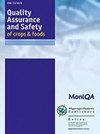不同配方黄连木油中微脂质体的物理稳定性
IF 5.3
3区 农林科学
Q1 FOOD SCIENCE & TECHNOLOGY
引用次数: 3
摘要
桐油(pistacia atlantica)作为一种植物源,富含酚类和生育酚类化合物,具有显著的抗氧化、治疗和抗菌作用。疏水化合物在脂质体体系中的包封是防止其在储存过程中被破坏的理想解决方案。脂质体的一个重要优点是利用天然磷脂(如卵磷脂)包封亲水性、疏水性和两亲性化合物,具有有益的作用。本研究的目的是以微脂质体的形式包封仁油。为此,采用Mozafari方法研究了以卵磷脂和胆固醇为基础的脂质体组成的影响。脂质体是用卵磷脂和胆固醇按60:0,50:10,40:20和30:30的比例制备的。对其粒径、粒径分布、zeta电位和包封效率进行了表征。结果表明,脂质体的大小与组成有关,但添加胆固醇对脂质体的大小有显著影响(P < 0.05)。颗粒的平均直径在4 ~ 9µm之间。当脂质体的比例为40:20时,脂质体的体积最小。施加胆固醇后,zeta电位由16.4 mV增加到32.39 mV,表明脂质体具有静电稳定性。总的来说,包封率为84.33%,40:20的比例被认为是微脂质体配方的理想浓度。基于以上结果,选择卵磷脂:胆固醇配比为40:20的荷叶油脂质体为最佳配方,其粒径较小,zeta电位较高,稳定性较好,可用于捕获、传递和释放亲水、亲脂肪和两亲性化合物(双亲)。本文章由计算机程序翻译,如有差异,请以英文原文为准。
Physical stability of microliposomes in bene (Pistacia atlantica) oil with different formulations
Bene oil (pistacia atlantica), as a plant source, is rich in phenolic and tocopherol compounds and has significant antioxidant, therapeutic and antimicrobial effects. Encapsulation of hydrophobic compounds in liposome system is an ideal solution for protecting them against destruction during storage. An important advantage of liposomes is the encapsulation of hydrophilic, hydrophobic and amphiphilic compounds by using natural phospholipids, such as lecithin, with beneficial effects. The aim of this study is to encapsulate the bene kernel oil in the form of microliposomes. For this purpose, the effect of composition of liposomes based on lecithin and cholesterol was studied using the Mozafari method. Liposomes are prepared using lecithin and cholesterol in the ratios of 60:0, 50:10, 40:20 and 30:30. Particle size, size distribution, zeta potential and encapsulation efficiency were charac-terised. According to the result, the size of liposomes was dependent on their composition, but the wasaffected significantly affected by adding cholesterol (P < 0.05). Average diameter of the particles was between 4 and 9 µm. Liposome with a ratio of 40:20 had the smallest size. By applying cholesterol, zeta potential increased from 16.4 mV to 32.39 mV, which indicates electrostatic stability of liposomes. In general, with encapsulation efficiency of 84.33%, the ratio of 40:20 is considered as an ideal concentration in the formulation of microliposomes. Based on the results, bene oil-loaded liposomes with a lecithin:cholesterol formulation ratio of :as 40:20 was chosen as an optimal formulation because of its smaller particle size, higher zeta potential and suitable stability, which can be used in trapping, delivering and releasing hydrophilic, adipose-friendly and amphiphilic compounds (dual-friendly).
求助全文
通过发布文献求助,成功后即可免费获取论文全文。
去求助
来源期刊

Quality Assurance and Safety of Crops & Foods
FOOD SCIENCE & TECHNOLOGY-
CiteScore
4.60
自引率
7.50%
发文量
61
审稿时长
1 months
期刊介绍:
''Quality Assurance and Safety of Crops & Foods'' is an international peer-reviewed journal publishing research and review papers associated with the quality and safety of food and food sources including cereals, grains, oilseeds, fruits, root crops and animal sources. It targets both primary materials and their conversion to human foods. There is a strong focus on the development and application of new analytical tools and their potential for quality assessment, assurance, control and safety. The scope includes issues of risk assessment, traceability, authenticity, food security and socio-economic impacts. Manuscripts presenting novel data and information that are likely to significantly contribute to scientific knowledge in areas of food quality and safety will be considered.
''Quality Assurance and Safety of Crops & Foods'' provides a forum for all those working in the specialist field of food quality and safety to report on the progress and outcomes of their research.
 求助内容:
求助内容: 应助结果提醒方式:
应助结果提醒方式:


